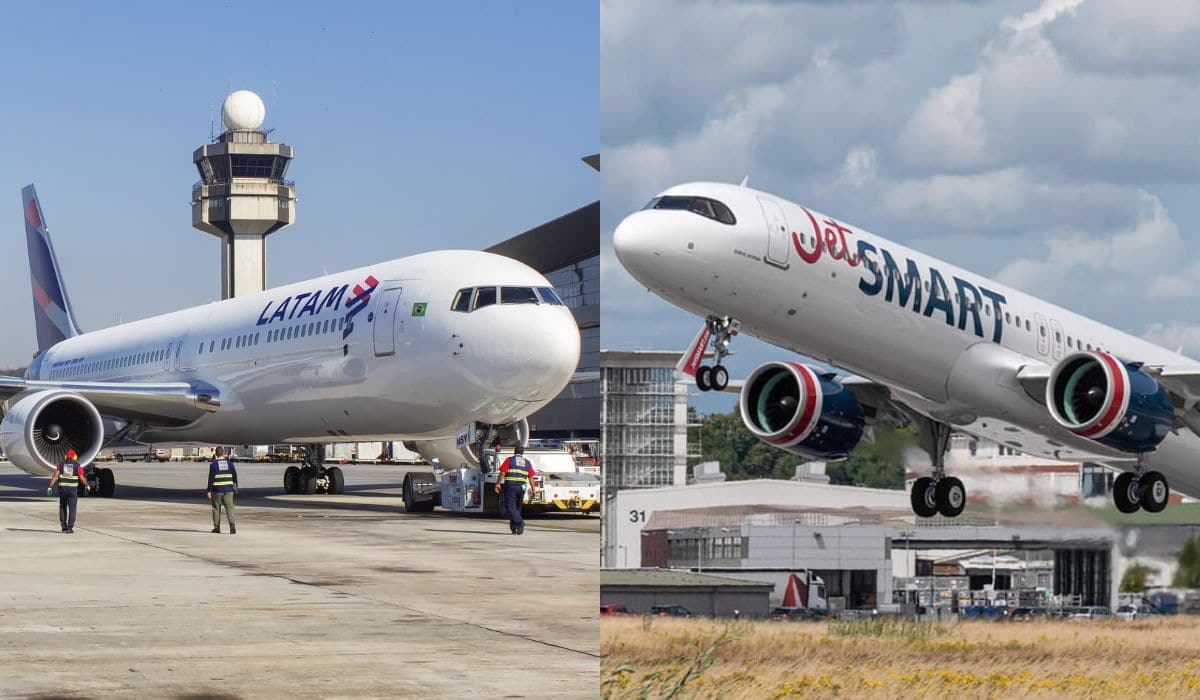The decision between JetSmart and LATAM Airlines represents a fundamental choice in how South American travelers approach air travel. These two carriers embody distinctly different philosophies: JetSmart as an ultra-low-cost pioneer reshaping regional aviation, and LATAM as the continent’s established legacy carrier with unmatched scale and international reach. Understanding their differences is essential for travelers, corporate clients, and anyone planning frequent trips through South America.
Airline Overview and Market Position
LATAM Airlines Group stands as Latin America’s undisputed leader in aviation, operating over 160 destinations across 28 countries with a combined fleet exceeding 300 aircraft. With major hubs in Santiago (Chile), Lima (Peru), São Paulo (Brazil), and Bogotá (Colombia), LATAM dominates through subsidiary operations in six South American countries and maintains extensive cargo services reaching 144 destinations. The airline earned recognition as the most sustainable airline in the Americas and fifth globally in S&P Global’s Sustainability Yearbook 2025.
JetSmart, in contrast, emerged as South America’s largest ultra-low-cost carrier (ULCC), founded in 2016 and backed by Indigo Partners. Operating a modern, all-Airbus A320 family fleet of 50 aircraft with ambitious plans to reach 100 by 2027, JetSmart has transported over 35 million passengers across more than 75 domestic and international routes spanning eight countries. The airline achieved recognition as the number three carrier in customer satisfaction by SKYTRAX World Airline Awards and surpassed LATAM in punctuality ratings during early 2025, achieving 98.8% on-time performance.
Route Network and Connectivity
The network differences between these carriers dramatically illustrate their distinct market strategies. LATAM’s international reach is unparalleled, maintaining extensive connections to Europe through its São Paulo hub, with daily flights to major European cities including Paris, London, Frankfurt, and Madrid. The airline also operates to over a dozen destinations outside South America, including regular service to the United States, which now includes new routes like Lima-London starting in December 2024.
JetSmart’s network remains primarily regional, concentrated on South American markets with 33 destinations across Chile, Argentina, Peru, Colombia, Brazil, Uruguay, Paraguay, Ecuador, and Bolivia. However, the airline’s rapid expansion in Colombia and recent opening of US sales channels signal growth ambitions. For travelers seeking direct international flights beyond South America—particularly to Europe, North America, or Asia—LATAM offers substantially more options. For intra-South American travel, JetSmart increasingly competes on selected routes.
Pricing and Fare Structure
This category represents perhaps the most significant difference between the airlines. JetSmart’s entire business model revolves around ultra-low base fares. Domestic flights frequently start under $30 USD, with competitive fares typically $25-$90 USD once modest baggage and seat selection are included. The airline pioneered transparent “à la carte” pricing: base SMART fare includes only a small personal item, with optional charges for checked baggage, carry-on bags, seat selection, and food.
LATAM operates with traditional airline pricing, reflecting its full-service positioning. While generally higher than JetSmart base fares, LATAM includes standard baggage allowances in many fare categories and incorporates services without additional charges. For budget-conscious travelers on basic short-haul flights, JetSmart offers undeniable value. However, travelers requiring baggage, seat selection, and conventional amenities often find prices more comparable than initial fare comparisons suggest.
Fleet, Safety, and Maintenance
Both airlines maintain strong safety records with modern fleets, though their approaches differ significantly. JetSmart operates exclusively new Airbus A320 family aircraft, with an average fleet age under five years. The fleet includes 11 A320-200s, 28 A320neos, and 11 A321neos currently in service, with 63 additional aircraft on order. All aircraft feature identical configurations, reducing complexity and supporting operational efficiency. JetSmart achieved 4-Star COVID-19 Airline Safety certification from Skytrax—the only low-cost airline in the Americas to receive this recognition—and maintains a perfect 7/7 safety rating from Airline Ratings.
LATAM operates significantly more aircraft diversity, including Airbus A319, A320, and A321 series, plus Boeing 767, 777, and 787 wide-body aircraft. This diversity enables long-haul operations but increases maintenance complexity. LATAM’s larger and longer-established operational history supports its international expansion, though the varied fleet requires sophisticated maintenance protocols.
Passenger Experience and Cabin Comfort
JetSmart’s cabin environment closely mirrors contemporary low-cost carriers, featuring clean, modern Airbus interiors with slimline Recaro seats offering approximately 29-30 inches of pitch and no recline. The seats provide surprisingly ergonomic support despite minimal padding. Cabin amenities reflect the ULCC model: no complimentary food, beverages, or entertainment; instead, snacks and drinks are available for purchase at modest prices ($2-$8 USD).
LATAM provides traditional full-service amenities, varying by fare class and route. Premium Business cabins feature specially designed seating inspired by South American culture and landscapes, with access to LATAM lounges at major hubs. Economy service includes complimentary beverages and snacks on most flights. For business and leisure travelers prioritizing comfort and included services, LATAM offers tangible advantages over JetSmart’s minimalist approach.
Customer Service and Support
This area represents a critical concern regarding JetSmart, where numerous customer reviews highlight significant service challenges. Customers report difficulties contacting human representatives, problems with online check-in systems, lack of communication regarding schedule changes, and unhelpful staff interactions. Common complaints include inability to reach support via phone, slow airport counter lines, and limited assistance when issues arise. The airline’s reliance on WhatsApp and limited Spanish-language phone support, combined with online chat systems that require navigating chatbots, frustrates many travelers.
LATAM maintains more robust customer service infrastructure, offering multilingual support, clearer communication channels, and established procedures for addressing passenger concerns. The airline’s scale and established operations support more comprehensive customer assistance. Travelers prioritizing responsive customer service should favor LATAM, particularly when traveling with families or anticipating complex itineraries.
Frequent Flyer Programs and Loyalty
LATAM Pass represents one of South America’s most developed frequent flyer programs, enabling members to earn miles on LATAM and partner airlines including Delta, Aeromexico, and Alaska Airlines. Status reaches four levels—Gold, Platinum, Black, and Black Signature—with benefits including seat upgrades, priority boarding, lounge access, baggage allowances, and same-day flight changes. Status qualifying points derive from spending rather than distance, allowing flexible achievement pathways.
JetSmart lacks a comparable frequent flyer program, reflecting its ultra-low-cost positioning. Occasional promotions offer discounted fares or bonus miles opportunities, but the airline does not maintain status tiers or traditional loyalty rewards. For frequent South American travelers accumulating substantial mileage, LATAM Pass provides measurable value; for occasional travelers, JetSmart’s low base fares eliminate the need for frequent flyer calculations.
Cargo and Business Services
LATAM’s cargo operations represent a substantial business division, with over 18 dedicated cargo aircraft transporting 144 destinations across 29 countries, moving over 901,000 tons in 2022. This capability makes LATAM essential for international shipping and time-sensitive business cargo. The airline also operates specialized freight forwarding services for corporate clients.
JetSmart’s operations focus exclusively on passenger transport, without developed cargo services. For businesses requiring air freight capabilities, LATAM is the only viable option between these carriers.
Sustainability and Environmental Responsibility
LATAM has established itself as a sustainability leader, achieving ranking as the most sustainable airline in the Americas with comprehensive climate strategies targeting 2050 carbon neutrality. The airline has invested in sustainable aviation fuels, plastic reduction (achieving 97% reduction in single-use plastic), and carbon offset programs, including the CO2BIO project in Colombian Orinoquía that has conserved 300,000 hectares of critical ecosystems.
JetSmart’s sustainability credentials remain less developed, though modern aircraft and operational efficiency deliver inherent fuel savings. The airline has not published comprehensive sustainability strategies comparable to LATAM’s initiatives. Environmentally conscious travelers may favor LATAM’s proven commitment to climate action.
Making Your Choice
The JetSmart versus LATAM decision fundamentally depends on travel priorities:
Choose JetSmart if you: prioritize cost savings on basic short-haul flights within South America, travel solo or with minimal baggage, accept minimal included amenities, and maintain flexibility regarding schedules and customer support.
Choose LATAM if you: require international connectivity beyond South America, value included services and passenger amenities, travel frequently (to leverage LATAM Pass benefits), need responsive customer support, require cargo services, or prioritize sustainability credentials and premium service quality.
For most regular business travelers and international voyagers, LATAM’s comprehensive network and services justify premium pricing. For budget-conscious leisure travelers focusing on South American exploration, JetSmart delivers exceptional value. Many travelers optimize costs by using JetSmart for budget regional flights while reserving LATAM for long-haul international and connection-critical journeys, leveraging each airline’s core strengths.



